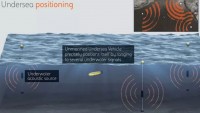US Army-funded Research Creates Graphene Microchips with One Million Times Faster Speeds
| Arthur Dominic Villasanta | | Jun 14, 2016 11:49 PM EDT |
(Photo : MIT) This illustration depicts the process of light emission from a sheet of graphene, which is represented as the blue lattice on the top surface of a carrier material. The light-colored arrow moving upwards at the center depicts a fast-moving electron. Because the electron is moving faster than light itself, it generates a shock wave, which spews out plasmons, shown as red squiggly lines, in two directions.
A man-made "optical boom" in a sheet of graphene can produce an intense, focused beam of light that will lead to the development of future microchips with speeds over a million times faster than those used in computers and mobile devices today.
Funded by the US Army, researchers at MIT, Israel, Croatia and Singapore discovered that a flow of electric current can, under certain circumstances, exceed the speed of slowed-down light and produce a kind of optical boom. This discovery represents an entirely new way of converting electricity into visible radiation.
Like Us on Facebook
It's fast, highly controllable and efficient, said the MIT researchers. More important, it will lead to a wide variety of new applications.
The researchers said using light instead of flowing electrons to move and store and data can massively increase microchip operating speeds up to incredibly higher levels compared to those in today's chips.
Although still theoretical, the discovery adds a new dimension to graphene's potential to produce blazingly fast microchips. Scientists at IBM Research have been exploring how graphene can be used to create new chips that exploit the way electrons move faster through graphene than through other semiconductor materials.
The optic boom allows electrons to pass through graphene at up to a million meters per second or 1/300 the speed of light in a vacuum. This represents a totally new way of producing light from electricity compared to light produced by LEDs or compact fluorescent lights.
This new "plasmon-based approach" might eventually be part of more efficient, more compact, faster and more tunable alternatives for certain applications, said the researchers.
More important, this is a way of efficiently and controllably generating plasmons on a scale compatible with current microchip technology. These graphene-based systems could potentially be key on-chip components in the development of new, light-based circuits, which are considered a major new direction in the evolution of computing technology toward ever-smaller and more efficient devices.
Plasmons are a kind of virtual particle that represents the oscillations of electrons on the surface.
The work was reported in the journal Nature Communications in a paper by two MIT professors: Marin Soljačić, professor of physics, and John Joannopoulos, the Francis Wright Davis Professor of physics and postdoc Ido Kaminer.
The team included researchers Yichen Shen, Ognjen Ilic, and Josue Lopez at MIT; Yaniv Katan at Technion, in Haifa, Israel; Hrvoje Buljan at the University of Zagreb in Croatia and Liang Jie Wong at the Singapore Institute of Manufacturing Technology.
The research was supported by the U.S. Army Research Laboratory and the U.S. Army Research Office through the Institute for Soldier Nanotechnologies at MIT.
TagsGraphene, optical boom, US Army, MIT
©2015 Chinatopix All rights reserved. Do not reproduce without permission
EDITOR'S PICKS
-

Did the Trump administration just announce plans for a trade war with ‘hostile’ China and Russia?
-

US Senate passes Taiwan travel bill slammed by China
-

As Yan Sihong’s family grieves, here are other Chinese students who went missing abroad. Some have never been found
-

Beijing blasts Western critics who ‘smear China’ with the term sharp power
-

China Envoy Seeks to Defuse Tensions With U.S. as a Trade War Brews
-

Singapore's Deputy PM Provides Bitcoin Vote of Confidence Amid China's Blanket Bans
-

China warns investors over risks in overseas virtual currency trading
-

Chinese government most trustworthy: survey
-

Kashima Antlers On Course For Back-To-Back Titles
MOST POPULAR
LATEST NEWS
Zhou Yongkang: China's Former Security Chief Sentenced to Life in Prison

China's former Chief of the Ministry of Public Security, Zhou Yongkang, has been given a life sentence after he was found guilty of abusing his office, bribery and deliberately ... Full Article
TRENDING STORY

China Pork Prices Expected to Stabilize As The Supplies Recover

Elephone P9000 Smartphone is now on Sale on Amazon India

There's a Big Chance Cliffhangers Won't Still Be Resolved When Grey's Anatomy Season 13 Returns

Supreme Court Ruled on Samsung vs Apple Dispute for Patent Infringement

Microsoft Surface Pro 5 Rumors and Release Date: What is the Latest?













